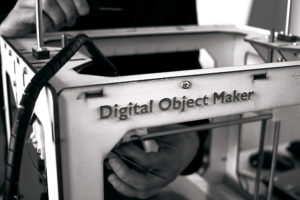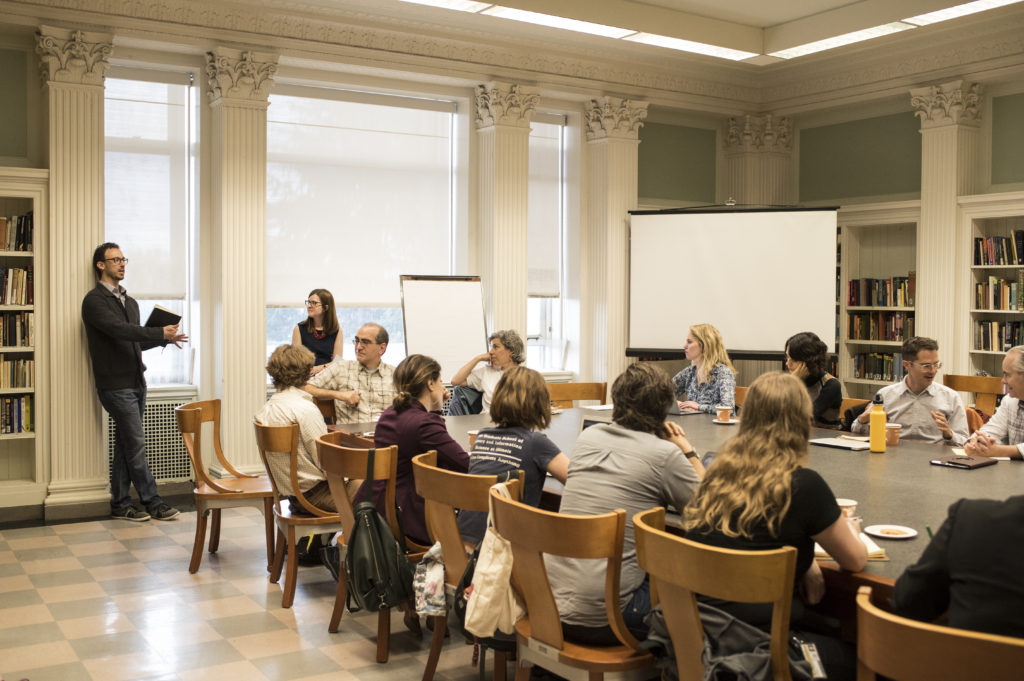Opening the Conversation About DH Project Preservation
By Rachael G. Samberg & Stacy Reardon

Digital Object Maker. Sayf, CC BY-NC-ND 2.0
After intensive research, hard work, and maybe even fundraising, you launch your digital humanities (DH) project into the world. Researchers anywhere have instant access to your web app, digital archive, data set, or project website. But what will happen to your scholarly output in five years? In twenty-five? What happens if you change institutions, or institutional priorities shift? Will your digital project be updated or forced to close up shop? Who should ensure that your project remains available to researchers? Which departments should guide long-term sustainability of your research?
Preservation of DH research outputs is critical for their future use, yet durable access questions often go unaddressed as DH projects take shape. Failure to account for projects’ enduring sustainability can leave gaps in cultural heritage and potentially eliminate years of scholarship and financial investments by funding organizations, institutions, and scholars.
To help avoid such scenarios, the UC Berkeley University Library and members of the Digital Humanities at Berkeley team (led here by Scott Paul McGinnis, Ph.D. student in history) hosted a recent event entitled Digital Humanities for Tomorrow, which sought to open the conversation about long-term preservation of the extraordinary DH projects being created at UC Berkeley.

What Is DH Preservation and Why Is It Important?
Ensuring that DH projects remain accessible over time is tricky. As MacDougall and Wynn (2015) explain, digital preservation imposes many technical challenges: Hardware and software grow obsolete; web and video standards evolve; digital bits degrade. As underlying infrastructures and formats change, keeping apace with technological developments over time becomes costly.
Complicating institutions’ ability to preserve DH projects is the fact that there is little consensus on what “preservation” means. What should researchers expect their projects to look like as time passes, and what should libraries and archival institutions promise will be available to future scholars? According to Johnston (2013), there are two main schools of thought on this:
Preserve the content and the look and feel exactly as they were implemented. This is often close to impossible.
Preserve the content but forgo the look and feel. This is often extremely unpopular.
Finally, of course, who should be responsible for the DH preservation decisions? As Cantara (2006) notes in her paper, “Long-term Preservation of Digital Humanities Scholarship,” while librarians, curators, and archivists have traditionally ensured the future viability and access to cultural heritage materials and scholarship, libraries and archives increasingly must act in partnership with researchers throughout the project creation process. This is due to the complex documentation and metadata needed to conserve, migrate, emulate, or translate multimedia DH materials and resources.
Identifying the Important Questions: The DH Salon
While long-term goals for DH project maintenance and accessibility may vary by institution and researcher, what’s clear is that researchers, libraries, archives, and other stakeholders should begin having conversations about DH stewardship throughout a project’s lifecycle. Ideally, researchers should work with librarians and archivists from project planning to completion to assess objectives.
Indeed, that was the idea behind UC Berkeley Library’s recent Digital Humanities preservation event on October 24, 2016, in which librarians, archivists, academic staff, faculty, and graduate students joined in an open conversation to begin developing a roadmap to guide preservation conversations.

The discussion took place as part of UC Berkeley Library’s programming for Open Access Week 2016 in recognition that the long-term preservation of scholarly content has to be part of any Open Access strategy, which (as the global coalition SPARC describes) seeks to make scholarship freely available online. While many Open Access journals and repositories have established preservation plans, the variation and technical challenges of DH projects have proven thorny to incorporate into existing infrastructure and best practices.
What Does DH Preservation Look Like?
Participants in the discussion aired different views regarding what preservation of DH projects might look like.
- In cases in which DH projects lead to traditional outputs such as a journal article, preservation may be relatively straightforward, relying on depositing materials in institutional repositories to preserve project data, metadata, and the resulting scholarship.
- When DH projects include an interactive component or if they make use of web applications, we need to ask whether preservation means maintaining full functionality of the project or if alternative strategies, such as a combination of screencasts, screenshots, descriptions, interviews, and other documentation would suffice.
Practical Outcomes
Although questions of what DH project preservation entails yielded few simple answers, some general practical principles emerged.
- Consider maintenance and preservation early in the project planning process, and involve experts who can help you along the way. Thinking ahead may help you run a more organized project by developing transparent file organization, backup processes, and a hand-off plan.
- Identify one person on your project team to be responsible for writing documentation understandable to outsiders, and keep track of the tools you use and their versions, as well as any metadata, rights, and provenance information for content.
- Long-term sustainability may also help guide technical choices. For example, consider following common standards and protocols, and choose open-source or widely-used software when possible. Well-considered decisions will make it easier for future project caretakers to update and maintain your project.
Next Steps
While at Berkeley some infrastructure is in place to help support the preservation of digital projects, the group brainstormed additional strategies that could complement what we already provide.
- Communication among a range of campus support staff would ensure researchers receive consistent and informed guidance no matter where they ask for help.
- Establishing best practices and workflows for common project types and developing a quick checklist to prepare projects to be “archive ready” could be part of this effort.
- In the long term, continuing to build staff expertise in born digital archiving should be part of the equation.
- Campus repositories and web archiving systems might be expanded and made more accessible.
There is still much to do to ensure born digital humanities scholarship survives for future researchers. The UCB Library and Digital Humanities at Berkeley look forward to tackling the challenges of preserving DH work at Berkeley.
About the Authors:
Rachael G. Samberg is UC Berkeley Library’s Scholarly Communication Officer. She was an intellectual property litigator, and a Lecturer in Law and Head of Reference & Instructional Services at Stanford Law School, before joining UC Berkeley in June 2016.
Stacy Reardon is the Literatures and Digital Humanities Librarian at UC Berkeley.